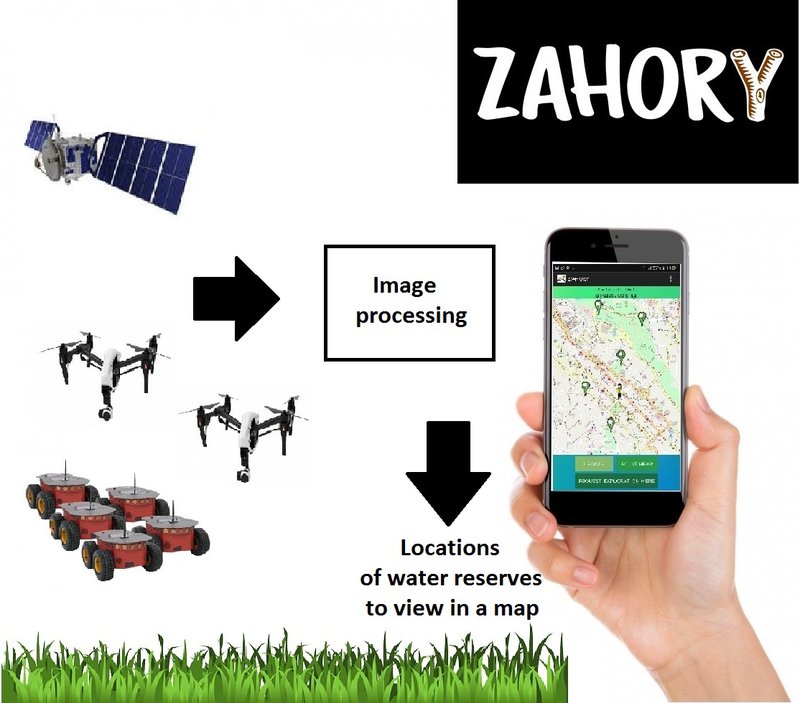UMA | Where's the Water?
Awards & Nominations
UMA has received the following awards and nominations. Way to go!
The Challenge | Where's the Water?
ZAHORY APP
ZAHORI is a mobile application to locate areas with groundwater reserves and study their behavior using satellites and autonomous exploration vehicles that collect images of the plants in the place of interest for further analysis and processing.

proyect sumary:
the motivation
We are UMA, a group of friends with great interest in thedevelopment of technologies to help our community. In 2016 our city suffered arationing of water because the dam dried, since then, the population has becomeaware of the importance of water, in that sense it is important to developtechnological tools that help to identify the location of water resources, notonly for its exploitation and consumption, but also for its preservation andcare. We developed ZAHORY an app inspired in the “dowsing”, a pseudo science inwhich people with a special "don", can detect streams of groundwater, instead of that, we use satellite data and exploration robotsthat collect information of the vegetation for its processing and latervisualization in the app.
zahorY app: a technological solution
ZAHORY is an application formobile devices that allows identifying areas where the probability of findingunderground water reserves is high. This information is obtained through aprocess of identification of the vegetation at the place of interest, usingautonomous exploration vehicles (heterogeneous multi-robot system) that collectimages of the existing vegetation for later analysis and processing, theobjective is to confirm or rule out the presence of phreatophytes, sincethey can be found along watercourses where there is a permanent flow of surfacewater or groundwater and in areas where the water table is close to thesurface.
The App and the User
The ZAHORY application, as a main function, allows users to visualize a map of the surroundings of their current location and at the same time identify locations where it is possible to find underground water reserves, also visualize surface water resources such as rivers, lakes, slopes and others. If there is no data available in the area of interest, the application allows users to request an exploration from their position and specifying a radius of the coverage area. Once the inspection request is made, the site is explored using autonomous vehicles that collect images of the existing vegetation for further processing and classification in the search for phreatic plants that are indicators of the existence of groundwater. Once the vegetation analysis process is finished, the new data (location of water resources) will be available to all users. The application also provides the user with data from NASA's GRACE mission that will assist in understanding the behavior of groundwater reserves, as a component of awareness of its use. The application also includes a user manual and information on the procedure of exploration with robots and image processing.
Heterogeneous Multi-robot System for Exploration
The heterogeneous multi-robot systems are groups of robots of different characteristics (UGV, AUV, UAV) designed with the objective of developing some collective behavior of utility in some application (in this case exploration) that involves performing tasks that would be impossible (or more conflicting) to perform by a single class of robot. With this kind of system we can easily explore a specific area, obtaining a wide view with air vehicles and an approach with terrestrial vehicles. The collective behavior emerges from the establishment of local rules of interaction between robots, this under the system distributed control approach, in which a robot does not need to know the overall state of the system only needs to know the state of its neighbors.
Image Processing to Identify Phreatophytic Plants
For the classification of images, we characterize thephotographs, taken in the exploration with robots, by their form, applying thealgorithm of the nearest neighbor with a database, the image can be identifiedand given a label.
NASA’s GRACE Data to Raise Awareness
We use the data available from NASA's GRACE mission to show in the application information about changes in groundwater reserves of the planet, this is achieved thanks to the GRACE mission that allows to appreciate changes in the gravitational field of the Earth, which is an indication of changes in the reservoirs of underground water resources. With this information, the user can understand the behavior of groundwater reserves and become aware of a responsible use of them knowing their availability over time.
PROYECTIONS
- In the future we will include more data from NASA to theZAHORY application that are related to changes in groundwater reserves to helpraise awareness about the use of water resources that are a common good thatmust be used in a responsible manner.
- We plan to deepen the images processing of the vegetation of the zones of interest since they can provide information on the degree of contamination of groundwater and thus establish plans of action for the protection of those natural resources.
ADITIONAL MATERIAL
Complete Demostration
Github
RESOURCEs
SOFTWARE
- Android Studio
- V-REP simulator
- MATLAB
Image Processing
- Murty, M. N., & Devi, V. S. (2011). Pattern recognition: An algorithmic approach. Springer Science & Business Media.
NASA’s GRACE Mission
Tracking groundwater changes around the world
Global surface mass according to GRACE data updated monthly
Heterogeneous Multi-Robot System
- Roldán, J. J., Garcia-Aunon, P., Garzón, M., de León, J., del Cerro, J., & Barrientos, A. (2016). Heterogeneous Multi-Robot System for Mapping Environmental Variables of Greenhouses. Sensors (Basel, Switzerland), 16(7), 1018. http://doi.org/10.3390/s16071018
SpaceApps is a NASA incubator innovation program.